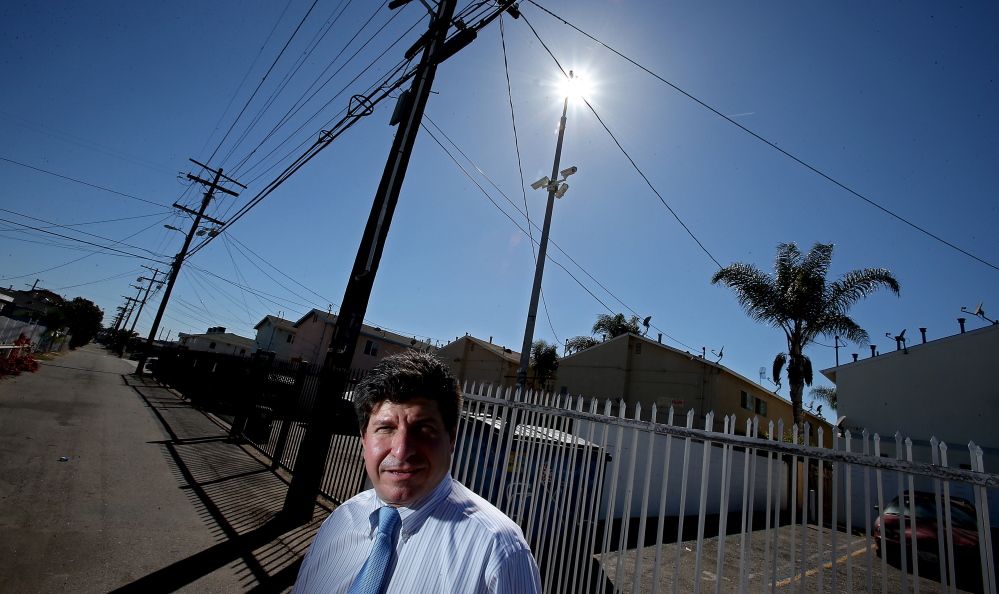LOS ANGELES — Arnie Corlin is driving the streets of Watts, police radio blaring.
Just days before, a man had been shot to death nearby in his car. Corlin navigates narrow roads with one-story homes and drives past churches and boarded-up markets, on the hunt for the next best thing to a witness to the killing: surveillance cameras.
Corlin, 57, doesn’t have a badge. He’s a Los Angeles Police Department volunteer and self-professed “gadget guy” who has aided in dozens of homicide investigations by tracking down and downloading surveillance video that may have captured a crime.
Corlin heads down East 92nd Street in his car and spots a two-story duplex with a camera on the side. He squints to see the numbers, and he pulls over to log the address.
Even if the camera didn’t catch the crime, it might have caught parts of the story.
“I’m keeping an open mind,” Corlin says.
His crime-fighting hobby began when he started to invest in rental properties in the 1990s and realized how many crimes are committed around or in rental units. He saw the cameras as a tool and installed surveillance systems on his properties in South L.A. in the early 2000s.
His theory was simple: If he could improve the quality of life for his residents, he’d have better tenants.
As he started working with property owners, he also formed relationships with police. He kept track of crime in the area and started volunteering to pull video from his own units.
“It kind of evolved,” he says.
On a recent afternoon, Corlin walks through the Southeast Community Police Station. A woman smiles and says, “Hi, Arnie.” He waves.
“They think I work here,” he says.
The task of searching for surveillance cameras can be tedious for detectives who need to conduct interviews in the first hours of an investigation.
“It’s a lot of driving, a lot of gas and a lot of time,” Corlin says. He spends about 100 hours a month helping the police.
Over the years, Corlin has learned a few things: Markets and liquor stores usually have surveillance systems. Homeowners usually place their cameras near the front door.
He knows more about cameras than does the average person, easily spotting the difference between a fake camera meant as a deterrent and a real one.
Corlin drives down a residential street, his head poking out the SUV window.
He passes a beige home with a yellow sign warning people they’re being recorded. “Smile, you’re on camera,” the sign reads. A camera is positioned near the roof.
“That’s a fake one,” he says confidently.
Corlin has an arsenal of tools (“his magic bag”) when he’s out working the camera beat.
He carries flashlights, magnifying glasses, numerous thumb drives and many cables. Camera systems can be kept in dark corners, and he needs the drives to save the video. He also brings a roll-up keyboard and multiple monitors.
“I have backups for backups,” he says.
The equipment is for times like one last year. He was running errands on a Saturday morning when he heard a call on the police radio. A man had been shot, and his car had crashed near a pole.
Corlin drove to the crime scene. The detectives had already found video from a nearby gas station but needed Corlin’s help in retrieving it from the computer.
The video showed the car crashing. Corlin went to work.
Hours later, the video was on a CD and in the detectives’ hands.
But Corlin’s job wasn’t done yet – detectives had found another camera in a nearby market. The recording showed the shooting, an edge for detectives.
A man on a bike had fired several shots at Leonel Estuardo Beltan.
In Beltran’s case, the video solidified the evidence. Jesus Lizarraga was convicted of murder in June and later sentenced to 40 years to life.
Corlin is “a tremendous help to us,” says LAPD Det. Rick Gordon, who oversees a group of detectives in Southeast Los Angeles. “He’s very good at what he does. He’s dedicated, a very selfless individual.”
Corlin, who was raised in Detroit, has had an interest in law enforcement dating to his teenage years.
He was as a volunteer traffic reporter in high school, where he learned to decipher police codes. Corlin came to Los Angeles in 1977 for a cousin’s wedding and never left. He started volunteering for the LAPD after the 1992 riots.
Send questions/comments to the editors.



Success. Please wait for the page to reload. If the page does not reload within 5 seconds, please refresh the page.
Enter your email and password to access comments.
Hi, to comment on stories you must . This profile is in addition to your subscription and website login.
Already have a commenting profile? .
Invalid username/password.
Please check your email to confirm and complete your registration.
Only subscribers are eligible to post comments. Please subscribe or login first for digital access. Here’s why.
Use the form below to reset your password. When you've submitted your account email, we will send an email with a reset code.